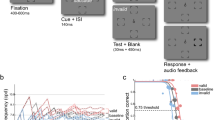Abstract
A sensory stimulus can only be properly interpreted in light of the stimuli that surround it in space and time. The tilt illusion (TI) and tilt after-effect (TAE) provide good evidence that the perception of a target depends strongly on both its spatial and temporal context. In previous studies, the TI and TAE have typically been investigated separately, so little is known about their co-effects on visual perception and information processing mechanisms. Here, we considered the influence of the spatial context and the temporal effect together and asked how center-surround context affects the TAE in foveal and para-foveal vision. Our results showed that different center-surround spatial patterns significantly affected the TAE for both foveal and para-foveal vision. In the fovea, the TAE was mainly produced by central adaptive gratings. Cross-oriented surroundings significantly inhibited the TAE, and iso-oriented surroundings slightly facilitated it; surround inhibition was much stronger than surround facilitation. In the para-fovea, the TAE was mainly decided by the surrounding patches. Likewise, a cross-oriented central patch inhibited the TAE, and an iso-oriented one facilitated it, but there was no significant difference between inhibition and facilitation. Our findings demonstrated, at the perceptual level, that our visual system adopts different mechanisms to process consistent or inconsistent central-surround orientation information and that the unequal magnitude of surround inhibition and facilitation is vitally important for the visual system to improve the detectability or discriminability of novel or incongruent stimuli.
Similar content being viewed by others
References
Schwartz O, Hsu A, Dayan P. Space and time in visual context. Nature Rev Neurosci 2007, 8: 522–535.
Schwartz O, Sejnowski T, Dayan P. Perceptual organization in the tilt illusion. J Vis 2009, 9: 1–20.
Clifford C, Spehar B, Solomon S, Martin P, Zaidi Q. Interactions between color and luminance in the perception of orientation. J Vis 2003, 3: 106–115.
Knapen T, Rolfs M, Wexler M, Cavanagh P. The reference frame of the tilt aftereffect. J Vis 2010, 10: 1–13.
Mareschal I, Clifford CW. Dynamics of unconscious contextual effects in orientation processing. Proc Natl Acad Sci U S A 2012, 109: 7553–7558.
Jin D Z, Dragoi V, Sur M, Seung HS. Tilt aftereffect and adaptation-induced changes in orientation tuning in visual cortex, J Neurophysiol 2005, 94: 4038–4050.
Clifford CW, Wenderoth P, Spehar B. A functional angle on some after-effects in cortical vision. Proc Biol Sci 2000, 267: 1705–1710.
Wissig S, Kohn A. The influence of surround suppression on adaptation effects in primary visual cortex. J Neurophysiol 2012, 107: 3370–3384.
Guo K, Nevado A, Robertson R, Pulgarin M, Thiele A, et al. Effects on orientation perception of manipulating the spatiotemporal prior probability of stimuli. Vision Res 2004, 44: 2349–2358.
Durant S, Clifford CW. Dynamics of the influence of segmentation cues on orientation perception. Vision Res 2006, 46: 2934–2940.
Xing J, Heeger DJ. Center-surround interactions in foveal and peripheral vision. Vision Res 2000, 40: 3065–3072.
Liu TS, Larsson J, Carrasco M. Feature-based attention modulates orientation-selective responses in human visual cortex. Neuron 2007, 55: 313–323.
Brainard DH. The psychophysics toolbox. Spat Vis 1997, 10: 433–436.
Pelli DG. The VideoToolbox software for visual psychophysics: Transforming numbers into movies. Spat Vis 1997, 10: 437–442.
Melcher D. Predictive remapping of visual features precedes saccadic eye movements. Nat Neurosci 2007, 10: 903–907.
Zimmermann E, Morrone MC, Fink GR, Burr D. Spatiotopic neur al representations develop slowly across saccades. Curr Biol 2013, 23: 193–194.
Parker D. Contrast and size variables and the tilt after-effect. Q J Exp Psychol 1972, 24: 1–7.
Solomon JA, Morgan MJ. Stochastic re-calibration: contextual effects on perceived tilt. Proc Biol Sci 2006, 273: 2681–2686.
Melcher D. Selective attention and the active remapping of object features in trans-saccadic perception. Vision Res 2009, 49: 1249–1255.
Zchaluk K. Foster DH. Model-free estimation of the psychometric function. Atten Percept Psychophys 2009, 71: 1414–1425.
Muir D, Over R. Tilt aftereffects in central and peripheral vision. J Exp Psychol 1970, 85: 165–170.
Greenwood JA, Bex PJ, Dakin SC. Crowding changes appearance. Curr Biol 2010, 20: 496–501.
Spivey MJ, Spirn M. Selective visual attention modulates the direct tilt aftereffect. Percept Psychophys 2000, 62: 1525–1533.
Li CY, Li W. Extensive integration field beyond the classical receptive field of cat’s striate cortical neurons: classification and tuning properties. Vision Res 1994, 34: 2337–2355.
Gilbert CD, Wiesel TN. The influence of contextual stimuli on the orientation selectivity of cells in primary visual cortex of the cat. Vision Res 1990, 30: 1689–1701.
Yao HS, Li CY. Clustered organization of neurons with similar extra-receptive field properties in the primary visual cortex. Neuron 2002, 35: 547–553.
Author information
Authors and Affiliations
Corresponding author
Rights and permissions
About this article
Cite this article
Chen, C., Chen, X., Gao, M. et al. Contextual influence on the tilt after-effect in foveal and para-foveal vision. Neurosci. Bull. 31, 307–316 (2015). https://doi.org/10.1007/s12264-014-1521-5
Received:
Accepted:
Published:
Issue Date:
DOI: https://doi.org/10.1007/s12264-014-1521-5




